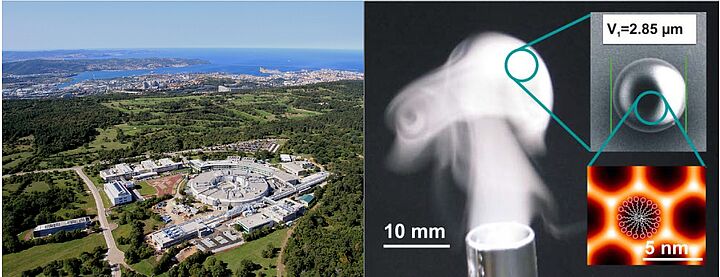Mittwoch, 05. Juni 2013, 09:30 - 11:00 iCal
SAXS beamline at ELETTRA and its application in aerosol research
Dr. Heinz Amenitsch, TU Graz
Fakultät für Physik, 1. Stock, Zimmer 55
Boltzmanngasse 5, 1090 Wien
Vortrag
EXPLORING THE SELF-ASSEMBLY OF MESOPOROUS MATERIALS IN THE GAS-PHASE IN SITU WITH SMALL ANGLE X-RAY SCATTERING
Heinz Amenitsch
Insitute of Inorganic Chemistry, Graz University of Technology, Graz, Austria &
Austrian SAXS beamline, Outstation – Institute of Inorganic Chemistry, Graz University of Technology, c/o Elettra-Sincrotrone Trieste, Basovizza (TS), Italy
Simultaneous Small and Wide Angle X-ray Scattering (SWAXS) is considered as standard tool for the structural characterization of nanomaterials in all states of matter: solution, solid, surfaces and gas phase. By combining it with results from other complementary methods like TEM, SEM, NMR or Crystallography, detailed structural informations, from atomic lattice up to the supramolecular envelope, can be obtained by performing simple and fast experiments under in situ conditions1. Different methods of analysis such as interferometry, IR- or Raman spectroscopy can also be coupled to the SWAXS setups, to perform parallel characterization of the samples and achieve a better and deeper understanding e.g. of the kinetics of chemical reactions, or of the mechanisms of growth and organization of nanostructured materials.
Evaporation induced self assembly (EISA)2 provides an attractive method for the synthesis of mesostructured materials. A fast and economically interesting process for the production of mesostructured particles is the spray-drying process of aerosol droplets, in which the mesophase formation proceeds within a few seconds, but still, a high degree of control on the final mesostructure is possible by applying suitable process parameters. Besides the chemical composition, also the external conditions influencing the evaporation rate (e.g. temperature, relative humidity) have been identified as key parameters for the resulting structure of the mesophase 3 .
Most of the previous studies have been performed on the dried aerosol and provided information on the effect of such parameters on the final structure e.g. 4 or at the end of the evaporation chamber 4,5. For the in situ study, various setups were designed that enables the gas-phase measurements during the evaporation process6. In an elongated evaporation vessel temperature gradients from a starting temperature (e.g. 5°C) to final temperatures up to 400 °C can be applied within a few centimetres in the axial direction and provoke a fast evaporation of the volatile components of the ESIA process. X-ray measurements can be taken at steps along the temperature profile in the dryer tube and the self-assembly process can be followed with SWAXS.
This presentation should give an overview of the different experiments starting from the ex-situ deposition, in situ experiments of mesoporous materials and finally hierarchical assembly of more complex structures.
1. Amenitsch,H. et al. First performance assessment of the small-angle X-ray scattering beamline at ELETTRA. Journal of Synchrotron Radiation 5, 506-508 (1998).
2. Brinker,C.J., Lu,Y., Sellinger,A. & Fan,H. Evaporation-induced self-assembly: Nanostructures made easy. Adv Mater 11, 579-585 (1999).
3. Boissiere,C., Grosso,D., Chaumonnot,A., Nicole,L. & Sanchez,C. Aerosol route to functional nanostructured inorganic and hybrid porous materials. Adv Mater 23, 599-623 (2011).
4. Shyjumon,I. et al. Mesostructured Silica Aerosol Particles: Comparison of Gas-Phase and Powder Deposit X-ray Diffraction Data. Langmuir 27, 5542-5548 (2011).
5. Boissiere,C. et al. First in-situ SAXS studies of the mesostructuration of spherical silica and titania particles during spray-drying process. Chemical Communications 9, 2798-2799 (2003).
6. Jungnikl,K. et al. Aerosol Flow Reactor with Controlled Temperature Gradient for In Situ Gas-Phase X-Ray Experiments-Measurements of Evaporation-Induced Self-Assembly (EISA) in Aerosols. Aerosol Science and Technology 45, 805-810 (2011).
Veranstalter
Kontakt
Paul Winkler
Fakultät für Physik
Aerosol- und Umweltphysik
+1-4277-73403
paul.winkler@univie.ac.at
Erstellt am Dienstag, 28. Mai 2013, 12:04
Letzte Änderung am Freitag, 31. Mai 2013, 13:54

